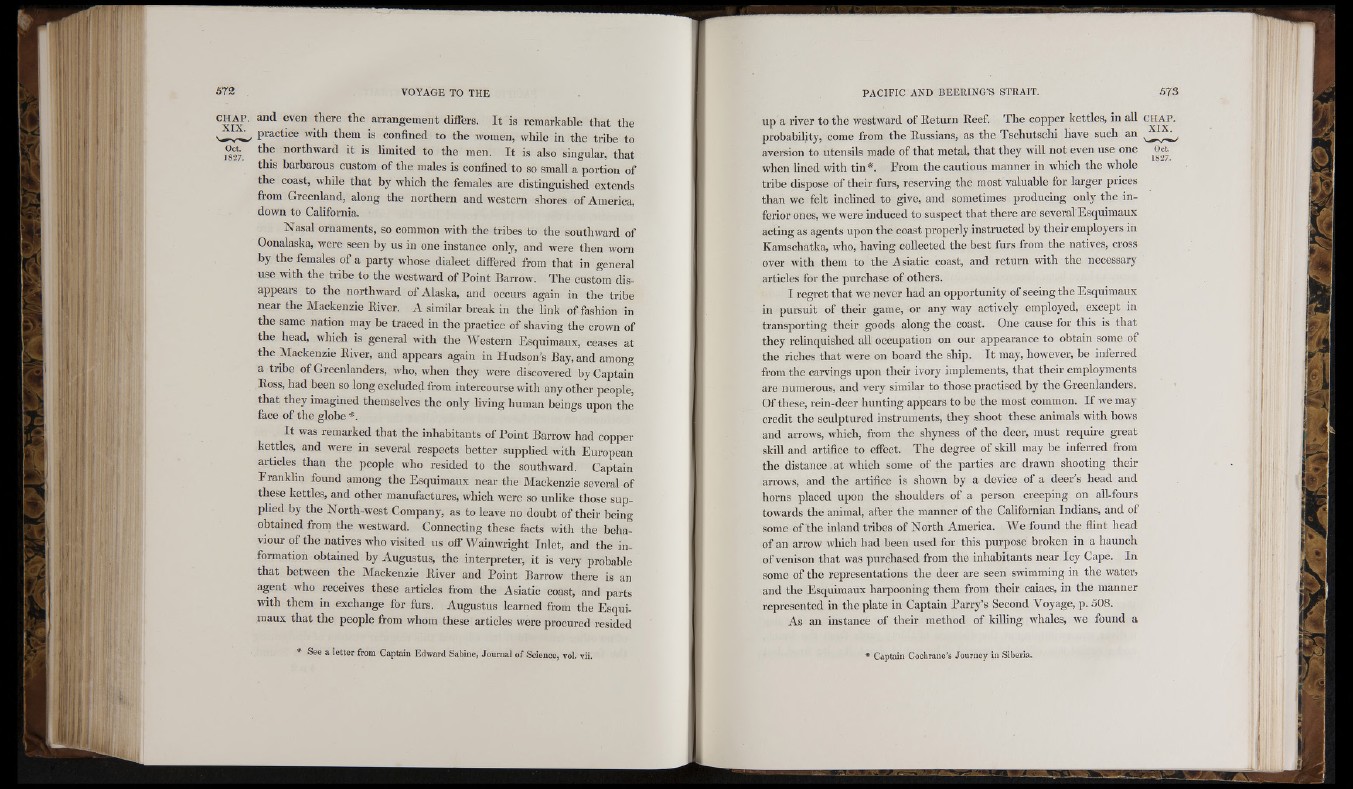
CHiAP. and even there the arrangement differs. It is remarkable that the
practice with them is confined to the women, while in the tribe to
Oc t the northward it is limited to the men. It is also singular, that
this barbarous custom of the males is confined to so small a portion of
the coast, while that by which the females are distinguished extends
from Greenland, along the northern and western shores of America,
down to California.
Nasal ornaments, so common with the tribes to the southward of
Oonalaska, were seen by us in one instance only, and were then worn
by the females of a party whose dialect differed from that in general
use with the tribe to the westward of Point Barrow. The custom disappears
to the northivard of Alaska, and occurs again in the tribe
near the Mackenzie River. A similar break in the link of fashion in
the same nation may be traced in the practice of shaving the crown of
the head, which is general with the AVestern Esquimaux, ceases at
the Mackenzie Eiver, and appears again in Hudson’s Bay, and among
a tribe of Greenlanders, who, when they were discovered by Captain
Eoss, had been so long excluded from intercourse with any other people,
that they imagined themselves the only living human beings upon the
face of the globe
It was remarked that the inhabitants of Point Barrow had copper
kettles, and were in several respects better supphed with European
articles than the people who resided to the southward. Captain
Frankhn found among the Esquimaux near the Mackenzie several of
these kettles, and other manufactures, which were so unlike those supplied
by the North-west Company, as to leave no doubt of their being
obtained from the westward. Connecting these facts with the behaviour
of the natives who visited us off AVainwright Inlet, and the information
obtained by Augustus, the interpreter, it is very probable
that between the Mackenzie River and Point Barrow there is an
agent who receives these articles from the Asiatic coast, and parts
with them in exchange for furs. Augustus learned from the Esquimaux
that the people from whom these articles were procured resided
* See a le tte r from Cap tain Edwa rd Sabine, Jo u rn a l o f Science, vol. vii.
I
up a river to the westw'ard of Return Eeef. The copper kettles, in all C H A P .
probability, come from the Eussians, as the Tschutschi have such an , ^
aversion to utensils made of that metal, that they will not even use one
Oct.
1827.
when lined with tin*. From the cautious manner in which the whole
tribe dispose of their furs, reserving the most valuable for larger prices
than we felt incUned to give, and sometimes producing only the inferior
ones, we were induced to suspect that there are several Esquimaux
acting as agents upon the coast properly instructed by their employers in
Kamsehatka, who, having collected the best furs from the natives, cross
over with them to the Asiatic coast, and return with the necessary
articles for the purchase of others.
I regret that we never had an opportunity of seeing the Esquimaux
in pursuit of their game, or any way actively employed, except in
transporting their goods along the coast. One cause for this is that
they relinquished all occupation on our appearance to obtain some of
the riches that ivere on board the ship. It may, however, be inferred
from the carvings upon their ivory implements, that their employments
are numerous, and very similar to those practised by the Greenlanders.
Ofthese, rein-deer hunting appears to be the most common. I f we may
credit the sculptured instruments, they shoot these animals with bows
and arrows, which, from the shyness of the deer, must require great
skill and artifice to effect. The degree of skill may be inferred from
the distance at which some of the parties are drawn shooting their
arrows, and the artifice is shown by a device of a deer s head and
horns placed upon the shoulders of a person creeping on all-fours
towards the animal, after the manner of the Californian Indians, and of
some of the inland tribes of North America. AVe found the flint head
of an arrow which had been used for this purpose broken in a haunch
of venison that was purchased from the inhabitants near Icy Cape. In
some of the representations the deer are seen swimming in the water,
and the Esquimaux harpooning them from their caiacs, in the manner
represented in the plate in Captain Parry’s Second Voyage, p. 608.
As an instance of their method of kiUing whales, we found a
* Captain Cochrane’s Jo u rn e y in Siberia.